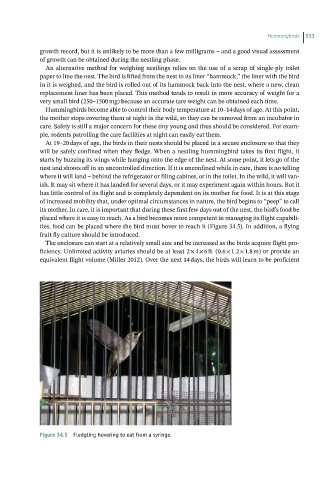Page 535 - Hand rearing birds second
P. 535
Hummingbirds 533
growth record, but it is unlikely to be more than a few milligrams – and a good visual assessment
of growth can be obtained during the nestling phase.
An alternative method for weighing nestlings relies on the use of a scrap of single‐ply toilet
paper to line the nest. The bird is lifted from the nest in its liner “hammock,” the liner with the bird
in it is weighed, and the bird is rolled out of its hammock back into the nest, where a new, clean
replacement liner has been placed. This method tends to result in more accuracy of weight for a
very small bird (250–1500 mg) because an accurate tare weight can be obtained each time.
Hummingbirds become able to control their body temperature at 10–14 days of age. At this point,
the mother stops covering them at night in the wild, so they can be removed from an incubator in
care. Safety is still a major concern for these tiny young and thus should be considered. For exam-
ple, rodents patrolling the care facilities at night can easily eat them.
At 19–20 days of age, the birds in their nests should be placed in a secure enclosure so that they
will be safely confined when they fledge. When a nestling hummingbird takes its first flight, it
starts by buzzing its wings while hanging onto the edge of the nest. At some point, it lets go of the
nest and shoots off in an uncontrolled direction. If it is unconfined while in care, there is no telling
where it will land – behind the refrigerator or filing cabinet, or in the toilet. In the wild, it will van-
ish. It may sit where it has landed for several days, or it may experiment again within hours. But it
has little control of its flight and is completely dependent on its mother for food. It is at this stage
of increased mobility that, under optimal circumstances in nature, the bird begins to “peep” to call
its mother. In care, it is important that during these first few days out of the nest, the bird’s food be
placed where it is easy to reach. As a bird becomes more competent in managing its flight capabili-
ties, food can be placed where the bird must hover to reach it (Figure 34.5). In addition, a flying
fruit fly culture should be introduced.
The enclosure can start at a relatively small size and be increased as the birds acquire flight pro-
ficiency. Unlimited activity aviaries should be at least 2 × 4 × 6 ft. (0.6 × 1.2 × 1.8 m) or provide an
equivalent flight volume (Miller 2012). Over the next 14 days, the birds will learn to be proficient
Figure 34.5 Fledgling hovering to eat from a syringe.

